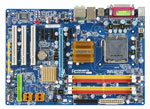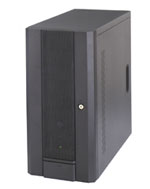Intel Budget Gaming
Traditionally, Intel offerings have tended to be on the more expensive side than configurations from AMD. However, as you shall see, this time the shoe is on the other foot, and we have a very competitive offering from Intel. It's no longer necessary to compromise performance in concession to the almighty dollar, and we are looking at two very strong budget gaming rigs from AMD and Intel.
| Intel Budget Gaming PC |
| Hardware |
Component |
Price |
Rebates |
| Processor |
Intel Core 2 Duo E4500
(2.2GHz 65W Allendale 2MB L2) |
$127 |
- |
| Motherboard |
Gigabyte GA-P35-DS3L
Intel P35 ATX |
$90 |
- |
| Memory |
Crucial Ballistix 2GB (2x1GB) DDR2-800 PC2-6400 |
$90 |
$40 |
| Video Card |
PNY GeForce 8800GT 512MB PCI-e 2.0 HDCP |
$260 |
- |
| Hard Drive |
Samsung SpinPoint T Series HD321KJ
320GB 16MB 7200RPM SATA 3.0GB/s |
$75 |
- |
| Optical Drive |
Samsung 20X DVDRW/DL SH-S202G |
$28 |
- |
| Case |
APEX TU150 Black Steel ATX with 400W |
$59 |
- |
| Display |
Acer 20" AL2016WBbd 5ms Widescreen DVI
(1680 x 1050) |
$200 |
- |
| Speakers |
Logitech X-530 70W RMS 5.1 |
$55 |
- |
| Input |
Logitech LX-710 Laser Black USB |
$55 |
- |
| Operating System |
Microsoft Vista Home Premium OEM |
$112 |
- |
| Bottom Line |
$1151 |
$1111 |
 |
Yes, we know we could have gone with the E6550, but that inches our budget up to nearly $1200 - close enough to our last midrange setup to make the difference rather meaningless. The E4500 clocks in at 2.2GHz and uses the Allendale core with just 2MB of L2 cache, while officially only supporting the older 800MHz Front Side Bus. The Allendale also lacks support for Intel's Virtualization technology, but some users are reporting the G0 stepping includes this. With our requirements, this is a moot point as it is mainly for use in server environments. The E4500 has proven to be a good overclocker and regularly overclocks in excess of 3.2GHz. Strangely, Newegg is listing the E4500 as $2 cheaper than the 2GHz E4400.
 |
With Intel G31/G33 motherboards providing woeful IGP performance compared to offerings from NVIDIA or AMD, how does Intel's enthusiast non-IGP chipset perform? Thankfully, it performs extremely well. Carrying on from the highly successful P965 series, we have the P35 chipset. Seemingly built with overclocking in mind, abit, ASUS, DFI, and Gigabyte have managed to produce a very nice selection of P35 motherboards for gamers. However, for our budget, we are limited to just a couple of options: the abit IP-35E or the Gigabyte GA-P35-DS3L. In the end, we chose the latter, because even though it is at the bottom of the P35-DS3 range from Gigabyte, it has proven to have all the vital features and overclocking ability of its more expensive brethren - and at a very attractive price.
 |
By this time, you may be wondering why we chose not to include an aftermarket CPU heatsink to go along with our CPU choices. For this budget, a $50 solution from Thermalright or Scythe was simply not an option, but with the stock AMD and Intel heatsinks incorporating heatpipe technology, we figured we'd still be good for a decent if not spectacular overclock.
The rest of the components are the same as those found in the AMD budget gaming system, and with AMD's HD 3800 (RV670) series still a couple of weeks away, the 8800 GT was an easy choice. Considering that overclocking will stress the CPU, motherboard, and RAM, it may be a wise investment to upgrade the power supply to something from Seasonic, Corsair, Enermax, or even Antec. Sound cards at this budget are simply an unnecessary luxury, and although a Creative Sound Blaster X-Fi would be an addition to complete our configuration, we're happy with onboard offerings - not to mention those soundcard driver issues we mentioned at the beginning; those were issues with the X-Fi.













63 Comments
View All Comments
BladeVenom - Thursday, November 8, 2007 - link
I have no problem with using those ultra low end power supplies for integrated graphic solutions, there's no way I'd use a 400 watt Allied power supply for a gaming machine.The smell of blown capacitors and electrical shorts is non to appealing to me.
BladeVenom - Thursday, November 8, 2007 - link
Allied is made by Deer; do you want to see another Deer psu in action? Here's a PowerTek also made by Deer.http://www.hardocp.com/article.html?art=MTMzOSwxMi...">http://www.hardocp.com/article.html?art=MTMzOSwxMi...
BladeVenom - Thursday, November 8, 2007 - link
http://www.jonnyguru.com/review_details.php?id=129...">http://www.jonnyguru.com/review_details.php?id=129...
DeepThought86 - Thursday, November 8, 2007 - link
Am I the only one that yearns for more vertical space and hates widescreens below 20"??Parhel - Thursday, November 8, 2007 - link
I don't like widescreen monitors in general. For the type of work I do, it doesn't help at all. For my home PC, I bought a Dell 20.1" 1600x1200 LCD, and I'll keep it until it dies if I can't get 4:3 monitors anymore.neon - Thursday, November 8, 2007 - link
You are not the only one. There are plenty of 19" to 21" 4:3 monitors that look great, and require less scrolling in business/web apps. I disagree with the assertion in the article, "As far as we're concerned, the sooner 4:3 displays die out, the better." They still have legitimate uses.However, the widescreens do seem well suited for budget gaming purposes. They have lower surface area, and so are cheaper to produce.
BigLan - Thursday, November 8, 2007 - link
I'm not a fan of smaller widescreens either. The nice thing is you can put them in portrait mode to see more than one page at a time in word or adobe.Sunrise089 - Thursday, November 8, 2007 - link
Agreed - at 22" and up, widescreen is superior, but a 19" widescreen is too small on the Y-axis.srenken - Thursday, November 8, 2007 - link
Like the title says. The Intel entry level PC table is switched with the AMD gaming system table.soydios - Thursday, November 8, 2007 - link
yep, check the tables on pages 3 and 4